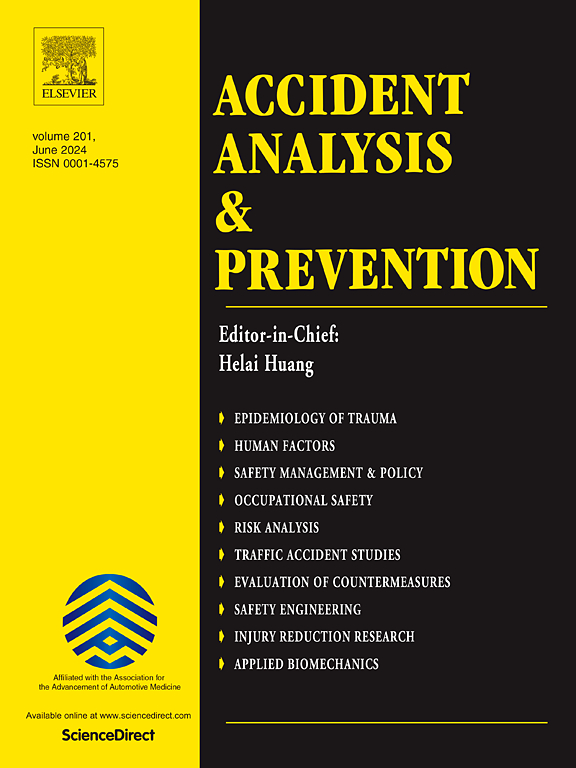将人为因素分析与分类系统应用于商用车事故调查与关键故障路径分析
IF 5.7
1区 工程技术
Q1 ERGONOMICS
引用次数: 0
摘要
本研究旨在开发一种可靠有效的人为因素分析与分类系统(HFACS)和贝叶斯网络(BN)方法,以了解商用车辆(CMV)交通事故的成因。HFACS-CMV 方法是从 100 起涉及至少 10 人死亡的多人伤亡交通事故中总结出来的。此类碰撞事故的极端性质确保了深入调查报告的存在,而这些报告是为 HFACS 分析提供充足数据所必需的。通过分析 2001 年至 2021 年中国 28 个省份的 100 份道路交通调查报告,该研究采用了几率比和 BN 方法,能够定量分析各诱因之间的关系。研究发现,在 HAFCS-CMV 框架的 4 个级别、12 个类别和 53 个子类别中,安全生产制度建立/执行不力、突发事件应对失误和超速的频率最高。上层与相邻下层之间存在许多关联,特别是在各个子类别中,公司监管不力与政府监督之间存在关联。带有 BN 的 HFACS-CMV 模型突出了一个关键的失效途径:政府监督不力导致公司监督不力或运营计划不周,从而导致操作员条件不达标和不安全行为。确定关联和失效路径对于制定有效的对策至关重要。具体结果受到所使用的碰撞报告的限制,因为这些报告并不是在考虑到高频碰撞控制系统的情况下生成的,因此未来使用基于高频碰撞控制系统的碰撞报告系统进行研究将是有益的。不过,该方法的成功应用证明了 HFACS-CMV 作为一种了解道路碰撞事故因果因素的可靠方法的效率和适用性。本文章由计算机程序翻译,如有差异,请以英文原文为准。
Applying human factors analysis and classification system for commercial vehicles crashes investigation and critical failure routes analysis
This study aims to develop a reliable and valid Human Factors Analysis and Classification System (HFACS) and Bayesian Network (BN) methodology to understand the causal factors of commercial vehicles (CMV) involved traffic crashes. The HFACS-CMV method has been established using learnings from 100 multi casualty crashes involving at least 10 fatalities. The extreme nature of such crashes ensures the existence of in-depth investigation reports which are necessary to generate sufficient data for HFACS analysis. By analyzing 100 road traffic investigation reports across 28 provinces in China from 2001 to 2021, the research employs odds ratio and BN which is able to quantitatively examine the relationships among contributing factors. The study identifies the highest frequencies of failures in establishing/implementing safety production systems, wrong responses to emergencies, and over speeding across four levels, 12 categories, and 53 sub-subcategories’ HAFCS-CMV framework. Numerous associations between the upper and adjacent lower levels are revealed, especially between poor company supervision and government oversight across various subcategories. The HFACS-CMV with BN model highlights a critical failure route: inadequate government oversight leading to poor company supervision or poorly planned operations, resulting in substandard operator conditions and unsafe acts. Identifying associations and failure routes is crucial for developing effective countermeasures. Specific outcomes are limited by the crash reports used which were not generated with HFACS in mind, future research using HFACS informed crash reporting systems would be beneficial. However, the successful application of the method demonstrates the efficiency and applicability of HFACS-CMV as a robust method for understanding causal factors of road crashes.
求助全文
通过发布文献求助,成功后即可免费获取论文全文。
去求助
来源期刊

Accident; analysis and prevention
Multiple-
CiteScore
11.90
自引率
16.90%
发文量
264
审稿时长
48 days
期刊介绍:
Accident Analysis & Prevention provides wide coverage of the general areas relating to accidental injury and damage, including the pre-injury and immediate post-injury phases. Published papers deal with medical, legal, economic, educational, behavioral, theoretical or empirical aspects of transportation accidents, as well as with accidents at other sites. Selected topics within the scope of the Journal may include: studies of human, environmental and vehicular factors influencing the occurrence, type and severity of accidents and injury; the design, implementation and evaluation of countermeasures; biomechanics of impact and human tolerance limits to injury; modelling and statistical analysis of accident data; policy, planning and decision-making in safety.
 求助内容:
求助内容: 应助结果提醒方式:
应助结果提醒方式:


